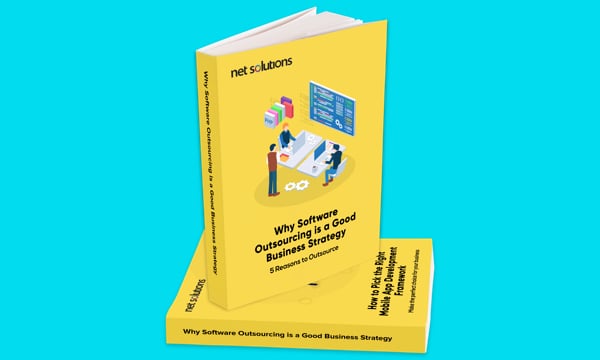Software development outsourcing offers a range of benefits compared to hiring an in-house team, from cost savings to scalability.
Even if you already have an in-house software development team, working with an outsourcing partner can extend their capabilities and help you bring software products to market much faster.
That’s why nearly three-quarters of today’s software development companies use outsourcing partners in some capacity. And with proper planning, you can also reap the rewards of outsourcing.
This blog post will explore the benefits of software development outsourcing and provide a step-by-step guide to take you from planning to deployment.
What Are the Benefits of Outsourcing Product Development?
When it comes to software product development, you can either hire an in-house team to handle everything, or you can opt to work with an outsourced team to manage all or part of the product development process.
Businesses large and small are choosing the software development outsourcing route because it offers several distinct advantages, including:
- Cost savings
- Access to expertise and specialized talent worldwide
- Faster time-to-market
- Flexibility and scalability
- Freeing up in-house teams to focus on their core strengths and focus on what they do best
Let’s explore each of these outsourcing benefits in greater detail.
1. Cost savings
Outsourcing product development offers a powerful cost reduction compared to hiring or augmenting an in-house team.
You might find this surprising if you’re not an accountant or a Human Resources professional. However, when you look at the balance sheet for hiring, onboarding, training, and paying benefits and payroll taxes, software development outsourcing is far less expensive than in-house development.
On top of that, you’ve got something called geo-arbitrage working in your favor if you’re headquartered in North America, Europe, or another fully industrialized region. Since wages and living costs are lower in emergent economies like India and Latin America, software development labor costs less in those parts of the world.
Visit our post about worldwide development rates for a complete breakdown of software development costs by country.
2. Access to specialized expertise
This is an amazing time to be alive, considering that entrepreneurs who want to develop new products have access to a talent pool that stretches across the entire planet.
That is important because quality products often require a variety of programming languages and a range of skill sets to produce. From product design to prototyping to project management, even creating a relatively simple Minimum Viable Product (MVP) demands a range of talents.
You may have an amazing in-house team, but there’s a good chance they don’t possess expertise in all the areas where you require support. Working with a software development outsourcing company gives you access to expertise that can supplement your in-house team’s efforts.
3. Faster time-to-market
What do Amazon, Uber, Coca-Cola, and Apple have in common? Every one of these companies brought their most popular products to market before anyone else.
The first product to hit the market often benefits from a phenomenon called the first-mover advantage. When done right, it lodges in the public’s mind as the gold standard for all products in its class, just as the iPhone remains the world’s most popular smartphone after more than 15 years.
Of course, even if you’re not aiming to be the first-mover with your software product, you can still benefit from outmaneuvering the competition and bringing features to market that your competitors haven’t yet introduced.
Outsourcing product development can help you move faster and bring your latest releases to the market quicker than the rest.
4. Better scalability
When your user base skyrockets and revenues start rolling in, it’s usually time to expand your infrastructure and double down on building new releases that serve a market need.
Scaling is incredibly challenging when you’re only working with an in-house team. However, when working with a good IT outsourcing partner, you’ve got access to a vast array of high-quality developers who can join your dedicated team on short notice.
The reverse is also true. If business slows and you need to reduce development for some time, that’s much easier when working with an outsourced development team. In that case, you’re not subject to the costs of hiring, lay-off, and rehiring new team members as the economy contracts and expands.
5. Improved focus on core competencies
If you’ve got a full-time staff working for you, you took the time to hire each team member based on their unique professional background and skill set. However, what often happens when developing new software, especially in startups, is that people wear many hats.
For example, a talented back-end coder may work on Quality Assurance simply because there aren’t enough in-house QA experts to handle that role. That pulls the developer away from their core competencies, making everyone less productive.
A far more strategic (and cost-effective) solution is to hire a software development outsourcing partner to take over those roles, leaving your in-house team members to focus on what they do best.

We respect your privacy. Your information is safe.
Step by Step: How to Outsource Software Product Development
Outsourcing software product development requires a strategic approach because your success will be tied to choosing the right partner and managing the relationship effectively.
That’s why it’s essential to understand the big picture, from defining your project goals and determining the most effective ways to communicate, collaborate, deploy, and support your software solution.
The following nine steps will help you work effectively with a software development outsourcing partner and bring your software product to market
1. Define your project goals and requirements
What are you hoping to accomplish with your software development project?
Sure, you’re probably dreaming of a wildly successful software product that becomes a market leader, but what is your path to get there? Are you planning to create an MVP first and receive feedback that guides future development? Do you have a different plan?
It’s essential to identify exactly what you’re trying to accomplish during your product discovery phase. You’ll also want to carefully consider what kind of services you require before looking for a software development company to assist you.
Of course, if you’re a non-technical founder, you may not know the exact technologies or programming language required to bring your product to life.
If that’s the case, just be clear about your business goals and general strategy—a qualified software development outsourcing partner can help you with the rest.
2. Research and select a suitable outsourcing partner
It doesn’t matter if you’re outsourcing the entire product development process to a third party or just a small portion of your development project—the team you choose to work with will impact everything.
Do your due diligence when researching software development outsourcing partners, and look for:
- Proven experience in the form of customer case studies
- Customer testimonials and reviews on websites like Clutch. co
- Years of experience in product management and development
- Tangible examples of products each company has built
- Solid communication skills (based on interviews you conduct with your top candidates)
- Technical expertise (which will also come through in the interview)
Also, consider issuing an RFP for software development services to solicit bids from prospective vendors.
3. Establish effective communication channels
Software development is a complicated, collaborative process, and it requires clear communication between everyone involved: UI and UX designers, developers, testers, project managers, etc.
In fact, the complex nature of software development inspired forward-thinking IT managers to create development methodologies like Agile Scrum, which we regularly use here at Net Solutions.
Whatever Software development methodology you and your partner decide to use, it’s important to identify clear guidelines for communication. Will you have regular Zoom meetings? Will you work in sprints (a key component of Agile)? How often will you meet with your project manager?
When using outsourced product development services overseas, it’s also essential to discuss how you plan to work in different time zones.
At Net Solutions, we can adapt our work hours to yours as we did for Soaq when we developed their video e-learning platform. However, you can use the timezone difference to your advantage if you’d like. For example, we can do QA testing while your in-house team sleeps, as we did for Kitco.
Whatever approach you take, it’s vital to hash out your communication and collaboration strategies before getting to work on your software product.
4. Create a detailed project plan and timeline
Now it’s time to dive into the details of your plan. Business owners, key stakeholders, project managers, and lead software engineers (both your in-house staff and those at the software development outsourcing firm) should meet to discuss the path forward.
Your detailed project plan should include key items like:
- Project goals
- Clearly defined roles for each team member (in-house and outsourced alike)
- Milestones with specific dates for key deliverables and deployments
- Potential risks that could impact the timeline and the project as a whole
- Plans to mitigate risk and overcome challenges
Once you’re clear on the path forward, you can confidently move to the next step.
5. Collaborate on project documentation and specifications
Collaboration requires clear documentation to enhance workflow and support your overall business strategy.
Work with your software development outsourcing partner to establish proper documentation and version control strategies for documents such as:
- Wireframes
- User personas and user stories
- Product roadmaps
- Project management notes and shared knowledge
- Tips and insights you’ve learned along the way
Will you share items on Google Drive? Will you collaborate on Slack, Asana, Basecamp, or other platforms?
Establish a clear documentation strategy before getting to work on design and development.
6. Maintain regular progress updates and feedback cycles
Regular communication and project updates are vital to reducing risk and delivering your project on time and within budget, not to mention producing a software application that lives up to your expectations.
Regular meetings and updates ensure that your software development outsourcing partner is correctly translating your business idea into a quality product, giving both parties a chance to correct course when necessary.
Software development is a complicated process, and you’ll discover things that will inform the direction you and your outsourcing partners take. Strategic product development means remaining flexible and open to new ideas, and you can only accomplish this through regular, honest communication.
7. Manage intellectual property and data security
Software developers deal with highly sensitive information—from the intellectual property that gives your software a competitive advantage to any customer data you might collect.
That’s why it’s essential to work with a trustworthy software development outsourcing partner who has been around for years and has a track record of dealing honestly with clients. You’ll also want to ensure your partner follows established best cybersecurity practices.
Once you’ve thoroughly vetted a prospective partner, establish and sign important documents like Non-Disclosure Agreements (NDAs) and anything else that will protect your interests.
8. Test and validate the software product
Quality Assurance may not be the most glamorous part of software development, but it’s necessary to produce a viable product and introduce it to the market.
QA, also known as testing, helps reduce the number of bugs impacting the product’s functionality. It also helps ensure compatibility and security compliance.
Make sure your outsourcing partner uses best practices for QA. Here at Net Solutions, we use an Agile, DevOps-fueled QA process to ensure your product is ready for release.
9. Transition to deployment and support
Deployment is where everything comes together, and it has to be seamless.
Whether your app is a brand-new product or an upgrade of an existing one, it must interact with other platforms and systems. Deployment is when you learn how your product will perform in real-world conditions.
Deployment is always a time of discovery, and even if everything works perfectly from the start, users will discover imperfections and make suggestions.
Forging a strong, collaborative, long-term relationship with a talented software development partner is key. Whether you’re starting with an MVP or a more developed software product, it will still require maintenance, modifications, and new features in future releases.
All this underscores the value of finding the right partner from the start. After all, who better to maintain and improve your product than the team by your side from the beginning?
That’s why we recommend thoroughly vetting any outsourcing partner you’re considering working with. Spend time to get to know them, and ask them challenging questions before signing any contracts.
A good software development outsourcing team will be as committed to your success as your in-house employees, and the right relationship will last for years—maybe even decades!
Ready to Talk Outsourcing?
Net Solutions has been in the software development business for over 30 years, working with world-renowned leaders from the Harvard Business Review to Euro Car Parts.
We pride ourselves on our strategic, collaborative approach to software development and our deep commitment to helping our clients succeed.
We’ll create powerful software products that spark user engagement, encourage repeat business, support your internal operations, and ensure your success.














